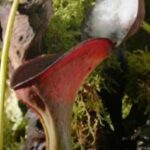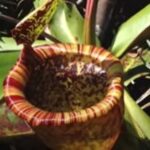As an Amazon Associate, this site earns commissions from qualifying purchases. For more details, click here.
Carnivorous plants have long fascinated botanists and ecologists for their remarkable adaptations that allow them to derive nutrients from animal prey. Among these, pitcher plants are particularly notable for their passive pitfall traps—modified leaves shaped like deep tubes, often filled with fluid and lined with slippery inner surfaces. These structures are designed to lure, capture, and digest insects and small arthropods. However, despite their predatory capabilities, pitcher plants themselves are not immune to being consumed, exploited, or damaged by a range of organisms. This article explores the various biotic agents that feed on, inhabit, or otherwise compromise pitcher plants, placing them in their broader ecological context.
Insect Inquilines and Kleptoparasites: Stealing the Plant’s Meal
One of the most significant threats to pitcher plants comes not from large herbivores, but from small invertebrates—particularly insect larvae that have evolved to live inside the pitcher’s fluid environment. These species, known as inquilines, are commensal or parasitic inhabitants that often feed on the remains of trapped prey or on microorganisms that thrive in the nutrient-rich fluid.
For example, the mosquito Wyeomyia smithii is highly adapted to live in the pitchers of Sarracenia purpurea, the purple pitcher plant native to North America. The mosquito’s larvae are immune to the plant’s digestive enzymes and feed on detritus and decomposing prey, effectively diverting nutrients that would otherwise be absorbed by the plant. Similarly, larvae of midges (Metriocnemus knabi) and flesh flies (Fletcherimyia fletcheri) also inhabit these pitchers and engage in kleptoparasitism—stealing resources intended for the plant.
Although these insects do not damage the plant structurally, their presence reduces the efficiency of nutrient acquisition. This can have long-term implications for the plant’s growth and reproductive success, especially in nutrient-poor habitats where each captured insect represents a valuable input of nitrogen and phosphorus.
Herbivory by Mammals and the Impact of Grazing
Pitcher plants are occasionally subject to direct herbivory by mammals, especially in environments where alternative food sources are scarce. Rodents such as voles and field mice have been observed gnawing on the leaves and stems of pitcher plants. These small mammals are primarily seeking moisture or limited nutrients from the plant tissue, particularly during drought conditions or in early spring before other vegetation emerges.
Larger herbivores, including deer, are also known to consume pitcher plant leaves opportunistically. In more extreme cases, bears have been reported to uproot or consume entire plants, though such interactions are relatively rare. While single events may not severely damage a mature population, consistent grazing pressure—especially in fragmented habitats—can reduce pitcher plant abundance and impair reproductive output.
Avian Interference: Predation by Proxy
Birds typically do not consume pitcher plants directly, but they can influence their ecological function by interacting with the plants’ insect prey. In some ecosystems, birds are drawn to pitcher plants by the movements and sounds of trapped insects. Upon inspection, birds may use their beaks to probe the pitcher, extracting prey before the plant has had time to digest it.
This behavior, while indirect, diminishes the effectiveness of the plant’s trapping mechanism. Moreover, repeated probing can damage the peristome (the lip of the pitcher) and inner surfaces, compromising the plant’s ability to attract and retain further prey. While avian interference is not the most serious threat to pitcher plant populations, it adds to the cumulative pressures that these species face in the wild.
Anthropogenic Use: Human Consumption and Cultural Applications
Human beings have also found uses for pitcher plants, particularly in Southeast Asia, where several species of Nepenthes are native. In some traditional practices, the hollow pitchers are used as natural containers to steam glutinous rice, creating a unique culinary experience. While this practice is generally sustainable when done at a small scale or using cultivated plants, overharvesting from wild populations poses a serious conservation risk.
Additionally, certain species have been used in traditional medicine, believed to possess antiseptic or digestive properties. Scientific validation of these uses remains limited, and most conservation biologists discourage the harvesting of pitcher plants from the wild due to the vulnerability of many species.
Pathogens and Microbial Decay: The Silent Consumers
While not predators in the conventional sense, fungi and bacteria play a significant role in the health and longevity of pitcher plants. Pathogenic fungi can infect damaged or senescent pitchers, especially when the plant is stressed due to drought, overcrowding, or poor nutrition. Species in the genera Fusarium and Botrytis, for instance, are known to cause tissue rot in a range of plant species and have been observed affecting pitcher plants under certain conditions.
Bacterial colonies also inhabit the pitcher fluid, and while many are mutualistic or neutral—assisting in prey decomposition—some can become pathogenic under specific environmental conditions. Microbial communities within the pitcher form complex food webs, and disruptions to these systems, whether due to pollution, climate change, or invasive species, can shift the balance toward decay rather than digestion.
Ecological Balance: Pitcher Plants as Both Predator and Prey
The idea of a carnivorous plant as prey challenges our expectations, yet it reinforces the reality that no organism exists in ecological isolation. Pitcher plants, despite their insect-trapping prowess, occupy a vulnerable niche. They are subject to pressures from parasitic insects, herbivorous mammals, opportunistic birds, microbial decay, and human exploitation.
Understanding who eats pitcher plants, and how, reveals a more nuanced view of these remarkable organisms. Their success depends not just on their ability to trap prey, but on their ability to survive in an ecosystem filled with both allies and antagonists. As we learn more about these plants and the communities they support, we come to appreciate the intricate dynamics of food webs where even the predator must watch its back.

My fascination with carnivorous plants began many, many years ago with Venus Fly Traps. Now I am more than happy to impart what I know with other enthusiasts and those who are curious about meat eating plants.


